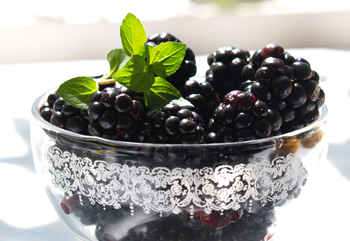
Blackberries / © Denzil Green
A blackberry is a small, soft, seedy fruit that ripens to black.
Culinarily, we refer to it and treat it as a berry, though botanically, it isn’t actually a true berry, but rather an agglomeration of individual berries known as a “drupelet.”
Cultivation and harvesting of blackberries
In England and in some parts of North America, blackberry bushes grow so wild and rampant that some firms specialize in their removal because they are seen as a nuisance.
The thorny, bramble bushes that they grow on flower in clusters, which then develop into berries somewhat resembling raspberries in that a “single” berry is multi-clustered. In urban settings, we have to pay dearly for these, but in rural settings, they are easily gathered along roads.
Blackberries ripen from green to red to black, and from hard to soft without being mooshy. If they are black and glossy, wait another few days until the black becomes duller in order to get the full sweetness (if the birds don’t get them before you.) If you are making preserves, you may want slightly less ripe ones which will be a bit harder and have a bit more pectin, though they will also be tarter.
Blackberries develop mould very quickly when crushed, so if you are buying them fresh in a container check the container for any signs of juice will which indicate crushed berries.
When harvested in August, they may still be slightly tart. Into September, and they’ll have reached their full sweetness. Both stages of ripeness are acceptable.
Traditionally, they should not be picked after Michaelmas (29 September.) See calendar entry on “Devil Spits Day“.
Cooking Tips
Wash only when you are ready to use (or freeze) them.
Blackberries have an incredible number of hard seeds that can get stuck in your teeth. If you purée them, you may wish to strain them to remove the seeds.
When making jam, some people prefer to leave in only about ¼ to ½ the seeds and strain the rest out.
The pH of blackberries ranges from 3.85 to 4.5 [1]FDA. Approximate pH of Foods and Food Products. April 2007. Accessed August 2017 at http://www.vldhealth.org/pdf/environmentalPDF/foodPH2007.pdf Consequently, if you are home canning them, consider adding a small amount of bottled lemon juice or citric acid to ensure a pH well below the upper safe cut off of 4.6.
Nutrition
Blackberries contain twice as much Vitamin C as blueberries.
A generous handful of blackberries contains 8 g of fibre (⅓ of the UK recommended daily amount), and half of your recommended daily intake of manganese.
They also contain folic acid (aka Vitamin B9, aka folate.)
Equivalents
1 kg (approx. 2 lbs) blackberries = 1 litre / 4 cups after crushing
1.25 kg (about 2.75 lbs) blackberries = 750 ml / 3 cups strained juice plus 500 g (about 1 lb) pomace
1 cup blackberry pomace = 250 g
1 pound blackberries = 450 g = 3 ½ cups blackberries = 1 ½ pints = 1 ½ cup mashed
1 pint punnet, whole blackberries = 2 cups = 300 g
1 dry pint blackberries = approximately 350 g (12 oz)
500 g / 1 lb blackberries = approximately 2 ⅔ cups whole = approximately 400 ml (1 ⅔ cups), crushed [2]Ball / Bernardin Complete Guide, 2015, page 427.
Storage Hints
Pick over and discard any crushed or mouldy berries. Refrigerate unwashed for up to two days spread out and covered with dampened paper towel.
Blackberries freeze well and stay whole after thawing — that is to say, they don’t collapse into moosh.
History Notes
Blackberries grow wild in many English hedge-rows. The alternative name, brambleberries (or bramberries), comes from an old name for the bush “brambel”, meaning prickly.
They were known and used by the Hebrews and the Greeks.
Recipes
- Apple & Berry Nut Crumble Recipe
- Roman Apple-Berry Tart Recipe
- Blackberry Jam (low- or no-sugar with Pomona Pectin)
- Blackberry Pie Filling
Sources
Peters, Rick. Seasonal food: blackberries. Manchester: The Guardian. 9 September 2010.
Venning, Annabel. Pick of the superfruits: There’s more fibre in a handful of blackberries than in two shredded wheat. London: Daily Mail. 20 August 2011.
References
| ↑1 | FDA. Approximate pH of Foods and Food Products. April 2007. Accessed August 2017 at http://www.vldhealth.org/pdf/environmentalPDF/foodPH2007.pdf |
|---|---|
| ↑2 | Ball / Bernardin Complete Guide, 2015, page 427. |

